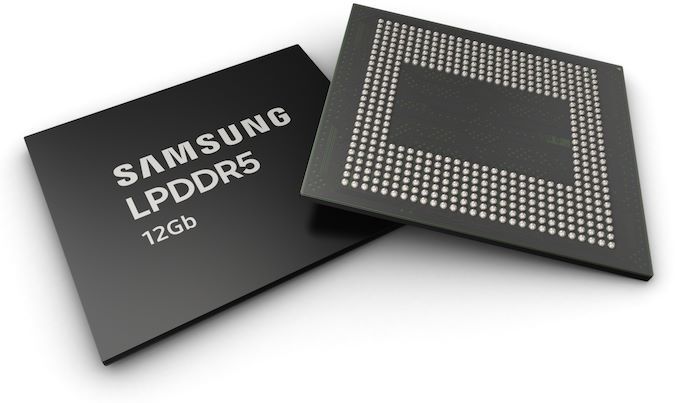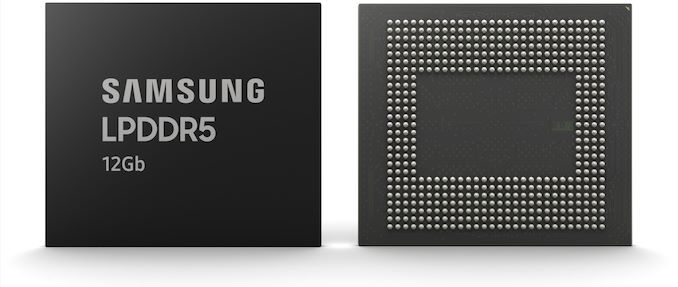Samsung Starts Production of LPDDR5-5500 Devices: 12 GB of DRAM in a Smartphone
by Anton Shilov on July 18, 2019 11:00 AM EST- Posted in
- Memory
- Samsung
- Smartphones
- Mobile
- LPDDR5

Samsung has kicked off volume production of its LPDDR5 memory devices and intends to start mass assembly of memory packages based on the new DRAMs. The company’s LPDDR5 memory will be used for upcoming flagship smartphones with up to 12 GB of memory in the coming months.
Samsung’s 12 Gb LPDDR5 memory devices feature a 5500 MT/s data transfer rate, which is about 30% higher when compared to currently used LPDDR4X-4266 DRAM. One of the first products to use the new 12 Gb LPDDR5 devices will be Samsung’s 12 GB LPDDR5 package featuring a 44 GB/s bandwidth.
The manufacturer produces its 12 Gb LPDDR5 chips using its 2nd Generation 10 nm-class process technology that enables it to make the new chips smaller (i.e., cheaper) and more power efficient, yet Samsung does not disclose exact voltages of these new DRAMs. What we do know is that the ICs feature a variable voltage that is up to 1.1 V. The producer claims that its LPDDR5 devices are 30% more power efficient than existing mobile memory chips because of a new circuit design with enhanced clocking, a new deep sleep mode, as well as low-power feature that guarantees stable operation at high clocks.
Assembly of 12 GB LPDDR5-5500 packages will commence later in July, which indicates that the company expects demand for these products in the coming months. Quite naturally, Samsung does not disclose customers interested in 12 GB of LPDDR5 memory, but there are a number of new flagship smartphone launches scheduled for the coming months, so we are going to find out soon. We do expect that Samsung is starting to build inventory for new 1Q2020 device launches which will have next-generation LP5 compatible SoCs in them as well.
Next year Samsung plans to release 16 Gb LPDDR5 devices and eventually increase data transfer rates of its LPDDR5 DRAMs all the way to 6400 MT/s. Meanwhile, as demand for LPDDR5 increases, Samsung may transfer production of this memory to its massive campus near Pyeongtaek, South Korea.
Related Reading:
- Samsung Announces First LPDDR5 DRAM Chip, Targets 6.4Gbps Data Rates & 30% Reduced Power
- Samsung Begins Mass Production of 12 GB LPDDR4X for Smartphones
- Samsung Starts Production of 16 Gb LPDDR4X Chips Using 2nd Gen 10nm Tech
- Micron Kicks Off Mass Production of 12 Gb LPDDR4X DRAM Chips
Source: Samsung











15 Comments
View All Comments
GreenReaper - Thursday, July 18, 2019 - link
You could put two or four together to make 3GB or 6GB, too, right? Don't *have* to have eight.Death666Angel - Thursday, July 18, 2019 - link
Going by my rather rudimentary understanding of the more intricate parts: If one chip has an 8 bit bus but the whole SoC has a 64 bit bus, then you need 8 12Gb chips to fully utilise the whole 64 bit memory bus of the chip. So by getting fewer chips you not only reduce capacity but also bandwidth.ksec - Thursday, July 18, 2019 - link
With these kind of capacity and speed, are there any reason not to use them on Desktop other than cost?JoeyJoJo123 - Thursday, July 18, 2019 - link
Artificial memory "shortages", and margins are much higher for smartphone class devices.It's pretty well known that desktop class hardware doesn't move the needle much for companies like Intel, where they focus on higher margin categories like server/mobile, and try to branch into socs (smartphones), smart devices, etc.
A high class memory chip sold to desktop users wouldn't make Samsung as much $$$ as if they stuck it onto a $2000 folding brick.
Rudde - Thursday, July 18, 2019 - link
I don't believe desktop cpus support lpddr5. Ice lake U supports lpddr4x, but whiskey lake is still at lpddr3. Therefore coffee lake hardly supports anything past lpddr3. I don't think amd supports low power ddr, definitely not lpddr5.I think the main roadblock is development of the memory controllers.
name99 - Thursday, July 18, 2019 - link
They are LPddr5Two issues:
(a) you need a DDR5 controller. Intel being Intel, they probably don’t have one and will trot out some excuse about “well it was scheduled for 7nm, but 7nm is delayed so everything associated with is is delayed; who could possibly have foreseen this?”
(b) Part of LP low power and high frequency comes from the DRAM dies being connected carefully and very close to the CPU/SoC. Ideally PoP or similar packaging, worst case soldering on the motherboard. If you want replaceable SIMMs/DIMMs you pay in power and frequency...
It remains unclear how this will play out.
APPLE is OK bcs they sell lots of stuff with hardwired memory, and customers accept it.
Other companies have plenty of customers who simultaneously complain that Apple is “unfair” because they run their DRAM fast AND that Apple is screwing their customers by not offering DRAM slots...
ikjadoon - Thursday, July 18, 2019 - link
Desktop systems aren't concerned about the power consumption between LPDDR5 (low-power DDR5) and DDR5. Plus, you will not like the price: even at volume quantities today, LPDDR4 costs 50% more than DDR4 per GB. Both were released in 2014.LP RAM also makes compromises for the lower power drain: because it refreshes the memory banks less often (i.e.,. the constant refreshes increase standby battery drain, a key metric for mobile devices), IIRC, LPDDR4 has latency penalties that DDR4 does not have.
And then...there are dozens of optimizations made for LPDDRX to be thinner (yup), smaller, and overall package sizes that drive up costs and don't have a real benefit for desktop users.
So, LPDDR"X" parts go where they're most needed / most valuable: mobile parts.
Source: https://www.avnet.com/shop/us/c/memory/dram-ics/?p...
PeachNCream - Thursday, July 18, 2019 - link
Waning desktop computing popularity is certainly a factor. There's a fair bit more money behind R&D for mobile devices these days because of their widespread adoption and explosive growth.webdoctors - Thursday, July 18, 2019 - link
What is all this memory used for in a smartphone?The Nintendo Switch only has 4 GB and plays more and much higher quality games than on any smartphone.
My 2 GB Moto G5+ is running Android Pie 9 Lineage addition without any problems. I have a 4 GB Moto phone thats not on Pie yet and it never hits any memory limits. Before adding more memory it would make sense to add the GPU HP to actually leverage this stuff.
Android gaming sucks today.
ikjadoon - Thursday, July 18, 2019 - link
... it's a maximum of 12 GB, not a minimum.Windows 10 Home has a 128 GB RAM maximum, while Windows 10 Pro has 2 TB RAM maximum.
The benefits of 2 GB+ are reducing compromises that do not apply to you in any way: more apps in the background, more live tabs in the browser, photo/video editing, lower system impact from image stacking (Night Sight, HDR, and others.), etc.
As mobile phones become the primary computing device for billions, clearly the demand is high.